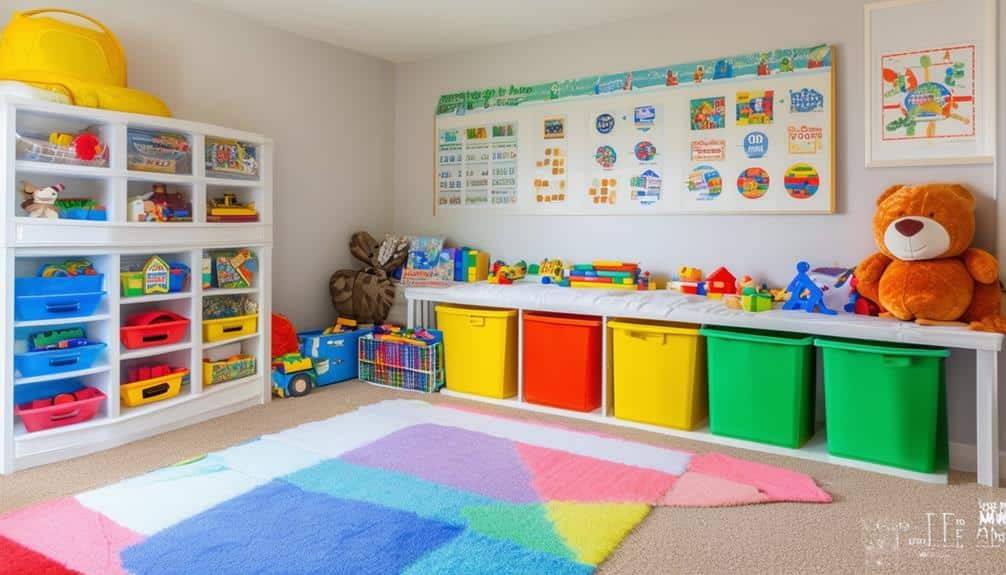Autism spectrum disorder (ASD) presents unique challenges in the daily lives of children with autism. Proven autism strategies focus on enhancing social communication skills, reducing challenging behaviors, and improving overall quality of life. DIR/Floortime, an evidence-based practice, emphasizes emotional connections and adaptive skills through play. This approach aims to enhance social interactions, cognitive skills, and everyday life functions for autistic children.
Pediatric occupational therapy also plays a crucial role in helping children with autism spectrum disorder develop essential motor and social skills. Techniques like the Picture Exchange Communication System and visual schedules aid language development and reduce symptom severity. These proven autism strategies are tailored to each student, ensuring that intervention services effectively address each child’s needs. Whether through speech-language therapy, occupational therapy, or social skills training, the goal is to enhance the child’s ability to navigate daily life, improving their social responsiveness, cognitive development, and overall well-being.
Key Takeaways
- Implement daily schedules and routines to provide predictability and reduce anxiety in autistic children.
- Develop personalized treatment plans tailored to the child’s abilities and interests to encourage development.
- Encourage nonverbal communication by understanding and responding to nonverbal cues and addressing sensory sensitivities.
- Utilize support services like speech, occupational, and behavior therapies, and join support groups for additional resources.
- Promote self-care skills and form support networks to foster future independence and development.
Cope with Autism Spectrum Disorder
While understanding Autism Spectrum Disorder (ASD) can seem overwhelming due to its complexity, it is essential to note that it affects approximately 1 in 54 children in the United States, requiring our collective attention and understanding. Challenges in social communication, restrictive behaviors, and specific interests characterize the disorder. These challenges, however, are not uniform across the spectrum, reflecting a wide range of abilities and difficulties.
An early diagnosis of ASD can lead to improved outcomes, hence the urgency in recognizing the signs. Parents, caregivers, and educators should know the indicators and seek professional consultation as soon as possible. The symptoms often involve deficits in social interaction, verbal and private communication difficulties, and repetitive behaviors.
Moreover, families with one child diagnosed with autism face approximately an 18.7% likelihood of having another child with the disorder. This recurring risk factor underscores the need for personalized guidance from healthcare providers or genetic counselors. Understanding ASD is not solely a scientific endeavor but a compassionate effort to enhance the lives of those affected and their families.
Importance of Early Intervention
Recognizing the pivotal role early intervention plays in the lives of children with autism is essential, as it can lead to significant improvements in social communication, behavior, and cognitive skills. Numerous studies have supported the benefits of early intervention, highlighting its potential to enhance a child’s long-term outcomes.
Early intervention equips these children with critical social skills that aid their daily interactions, fostering healthier relationships and promoting a better understanding of their environment. This proactive approach can help reduce challenging behaviors, improve language development, and enhance adaptive functioning. Children who receive timely intervention demonstrate increased progress, indicating its profound influence on their developmental trajectory.
Given the specific needs of each child with autism, early intervention services should be tailored to address individual needs. This personalized approach often involves creating an Individualized Education Plan (IEP), which outlines specific goals and strategies to promote skill development. Providing these services not only aids in the child’s growth but also enhances their overall quality of life. Therefore, the significance of early intervention in the context of autism cannot be overstated. It is a crucial step towards fostering future development and ensuring a more fulfilling life for these children.
Creating a Structured Environment

Creating a structured setting is crucial for children with autism, as it gives them a sense of security and predictability, thus nurturing their growth. This entails introducing daily routines and maintaining consistency in their surroundings, which can significantly diminish anxiety and improve their understanding of daily tasks. Tailored treatment plans, therefore, should include tactics focused on cultivating such settings to enhance concentration, encourage autonomy, and minimize problematic behaviors.
Implementing Daily Schedules
Implementing daily schedules can significantly enhance the development of children with autism. These structured routines provide a much-needed sense of predictability, promote independence, and reduce anxiety. Children with autism often struggle with changes and unexpected alterations, but with visual schedules, they can better understand and follow the flow of the day.
Visual schedules, utilizing pictures or symbols to represent tasks or activities, offer a clear, tangible guideline for the child to reference. This not only aids in comprehension but also reinforces communication skills as the child learns to associate symbols with actions or events.
Moreover, structured routines offer a platform for systematically teaching new skills and behaviors. They allow the child to practice these skills regularly, promoting mastery over time. The predictability of routines can also alleviate the stress and anxiety often associated with unknown situations.
The research underscores the value of implementing structured routines. Consistent schedules facilitate smoother changes and foster improved behavior as the child gains control over their environment. In sum, daily schedules are a powerful tool in promoting the development of children with autism.
Consistency in Environment
In autism care, providing a steady and organized environment is crucial in fostering a sense of security, promoting understanding, and facilitating smoother shifts for children. Consistency in the environment helps these children feel secure and comprehend expectations. This structured environment reduces anxiety and supports learning and development.
Maintaining a consistent routine can improve behavior, communication, and overall well-being in autistic children. Predictable environments, on the other hand, ease children’s navigation through daily activities and changes. By providing a stable and structured setting, we foster a sense of security and comfort for children with autism, thereby paving the way for their future development.
Here is a concise table summarizing the benefits of a steady and organized environment for children with autism:
| Benefit | Explanation |
|---|---|
| Security | An organized environment fosters a sense of safety and comfort. |
| Understanding | Consistency helps children with autism comprehend expectations. |
| Reduced Anxiety | Routine activities in a predictable environment lessen anxiety. |
| Improved Behavior | Consistent routines can enhance behavior and communication. |
| Smooth Transitions | Predictable environments facilitate smoother shifts in activities. |
Personalized Treatment Plans
While a consistent environment can’t be emphasized enough, a genuinely practical approach to supporting autistic children goes beyond maintaining a routine. It involves creating individualized treatment plans tailored to their unique needs and challenges.
Creating tailored treatment plans that offer a structured environment is essential. This structure should provide a sense of predictability and be adapted to the child’s distinct abilities and interests. Implementing visual cues can significantly aid in this process. These can be leveraged to help the child understand their environment and navigate their day-to-day life more efficiently.
Similarly, positive reinforcement is a crucial aspect of these plans. By recognizing and rewarding good behavior, we can encourage repetition, reinforcing the structured routines outlined in the child’s treatment plan. This approach fosters a sense of accomplishment and self-worth in the child, enhancing their overall development.
Lastly, it is vital to review and adjust these treatment plans regularly. As the child grows and their needs evolve, the interventions must adapt accordingly to ensure they continue supporting their developmental progress. This ongoing customization is the foundation of tailored treatment plans for autistic children.
Encouraging Nonverbal Communication
Enhancing verbal communication in children with autism is a significant step towards fostering their future development. Understanding gestures and addressing sensory sensitivities can create inclusive strategies encouraging expressive and receptive communication. When supported by suitable tools and techniques, these aspects of nonverbal interaction can empower these children to communicate more effectively and independently.
Understanding Nonverbal Cues
Exploring the silent language of nonverbal signals is essential in connecting with children with autism. These children may often rely more on gestures, facial expressions, body language, and eye contact than verbal communication to express their needs and emotions. Caregivers and educators need to understand that this form of communication is just as valid and meaningful as spoken language.
Working towards understanding nonverbal signals in children with autism requires patience, observation, and a deep sense of empathy. It’s essential to:
- Recognize and interpret a child’s distinct nonverbal signals.
- Engage in activities that encourage nonverbal communication.
- Validate their nonverbal expressions by responding appropriately.
- Foster an environment that respects and promotes their exceptional form of communication.
Addressing Sensory Sensitivities
Exploring sensory sensitivities for children with autism is crucial to nurturing their future growth, particularly in improving their nonverbal communication skills. Sensory sensitivities may appear in various ways, from heightened reactions to sounds and textures to challenges with balance and perception. Understanding these sensitivities involves careful observation of a child’s responses to different stimuli, enabling caregivers to pinpoint and address specific sensory needs.
Establishing a sensory-friendly environment at home can significantly diminish sensory overload, promoting comfort and safety. This includes reducing potentially distressing stimuli and incorporating sensory activities that can meet a child’s particular requirements. These activities could involve swinging, engaging in textured play, or experiencing deep pressure input, all of which can offer positive sensory experiences.
Nonverbal communication, often underestimated, is a vital tool in connecting with children with autism. Encouraging the advancement of these skills, such as interpreting and responding to facial expressions, gestures, and body language, can enhance social interactions and emotional expression. A supportive, empathetic approach can profoundly influence a child’s capacity to communicate their sensory experiences, thereby nurturing their overall growth.
Addressing Sensory Sensitivities

Exploring the maze of sensory sensitivities, which can appear as hypersensitivity or hyposensitivity to sensory input, is vital to fostering development in children with autism. Sensory sensitivities can significantly impact a child’s behavior, communication, and interaction with their environment. It is essential to address these sensitivities in an understanding and effective manner.
One of the primary steps in creating a sensory-friendly setting is minimizing exposure to distressing stimuli while incorporating sensory activities that the child finds calming or enjoyable. Such activities could range from tactile play with different textures to visual games encouraging focus and attention.
Occupational therapy plays a pivotal role in guiding sensory sensitivities. Occupational therapists are equipped with strategies that can help children with autism regulate their sensory experiences. Some of these strategies include:
- Designing tailored sensory diets with activities that aid in regulating the nervous system
- Using therapeutic techniques like deep pressure and heavy work activities
- Implementing gradual desensitization techniques to reduce sensory aversions
- Guiding parents in creating a predictable and structured daily routine
Personalizing Autism Treatments
Delving into the realm of tailored autism treatments, it becomes clear that these interventions, customized to meet the specific needs of each child with autism, are essential for maximizing the effectiveness of therapeutic strategies. The concept of tailoring treatments is rooted in the understanding that each child with autism presents distinct challenges and potentials. Therefore, the ‘one-size-fits-all’ approach is ineffective and inhibits the child’s growth and development.
The Individualized Education Plan (IEP) is a significant tool in this customization process. It outlines specific behavioral interventions and social skills training tailored to your child’s requirements, ensuring a comprehensive developmental approach. Regularly reviewing and adjusting this plan in response to the child’s progress further enhances the effectiveness of personalized treatment.
Understanding what stresses or calms a specific child and incorporating this knowledge into the IEP is essential. Parents and caregivers can optimize the benefits of customized treatments by identifying triggers for challenging behaviors and adapting behavioral interventions accordingly.
Embracing DIR/Floortime for Autism Development
Utilizing Support Services

Often overlooked yet vitally important, support services such as speech, occupational, and behavior therapies play a pivotal role in enhancing the developmental trajectory of children with autism. These support services are designed to address the unique needs of each child, focusing on areas such as language development, social interactions, sensory processing, and self-care skills.
The rise of digital technology has also introduced the option of online therapy services, making these essential supports more accessible than ever. This can be especially beneficial for children struggling with traditional therapy settings, offering a comfortable, familiar environment to engage and learn.
Visual supports should also be considered. These can significantly help in comprehension and communication for children with autism, providing a clear, visual representation of concepts and expectations.
Key strategies might include:
- They are regularly accessing speech, occupational, and behavior therapies, both in-person and through online therapy options.
- Utilizing visual supports in daily routines and learning activities.
- We collaborate with therapists to develop a personalized intervention plan based on the child’s needs.
- I am joining autism support groups to connect with other parents and gain access to additional resources.
The right support services can make all the difference in fostering future development for children with autism.
Educational Rights and Services
While the utilization of support services plays a fundamental role in improving the developmental trajectory of children with autism, it is equally important to recognize and understand the educational rights and services available to these children. The U.S. government provides free services to guarantee that the academic needs of every child with autism are met. These services are tailored to cater to each child’s distinct needs, promoting their best possible future growth and development.
Parents and caregivers should be actively involved in developing the child’s Personalized Education Plan (PEP). This plan is a crucial component of autism treatment, as it is designed to meet the child’s needs and enhance their learning experience.
| Educational Rights | Description |
|---|---|
| Early Intervention | Special education services for children in their early years |
| Personalized Education Plan (PEP) | A legal document detailing the child’s needs and services required |
| Government Services | The U.S. government provides free services to meet children’s education needs. |
Understanding and accessing these educational rights and services can significantly impact a child’s developmental journey. Hence, it is essential to be informed about these rights and use them effectively to better the child’s future.
Promoting Self-Care and Support Networks

Promoting self-care skills in autistic children is vital for their future independence, especially in hygiene-related tasks. Equally important is developing a solid support network, providing resources and shared experiences for families navigating this journey. These two aspects, self-care and support networks, are essential to fostering growth and development in children with autism.
Prioritizing Personal Hygiene
In fostering future development for children with autism, prioritizing self-care emerges as a critical factor in promoting hygiene and creating supportive networks. Hygiene routines are crucial in encouraging independence and self-reliance in children with autism. Visual aids like hygiene checklists effectively master hygiene tasks and promote event and self-confidence.
Another strategic approach is creating hygiene kits. These kits guarantee easy access to care items, promoting consistency in hygiene practices. They can also be customized according to the child’s preferences and needs, making the process more engaging.
Furthermore, collaboration with support networks is essential in reinforcing these practices. This could involve family members, therapists, and educators who can provide consistent, supportive reinforcement of these hygiene routines at home and within community settings.
Lastly, it is essential to include hygiene tasks in the child’s Individualized Education Plan (IEP). This guarantees that the child receives thorough support in mastering these skills at home and within educational settings. These efforts will undoubtedly contribute to the autonomous and confident growth of autistic children.
Building Support Networks
Managing the complexities of parenting a child with autism can be challenging, yet the establishment of a robust support network can dramatically reduce feelings of isolation and stress. Indeed, a staggering 84% of parents report heightened stress levels, with 77% feeling isolated. Support networks serve to alleviate these burdens, offering practical advice and a shared understanding of experiences.
Engaging with such networks can improve coping strategies, increase resilience, and improve overall mental well-being. These networks empower parents by guiding them through challenges, helping them access resources, and enabling them to advocate more effectively for their child’s needs.
In today’s digital age, online resources provide an accessible connection. Forums and social media groups are populated with parents and autism advocates, creating a wealth of knowledge and support. These platforms facilitate communication, understanding, and mutual support.
Parents of children with autism should be encouraged to establish and utilize support networks. This step is integral to their well-being and their ability to foster their child’s future development. In sum, a parent’s guide to dealing with autism is incomplete without the inclusion of support networks.
Ensuring Online Safety for Children

Exploring the digital landscape presents a unique set of challenges for children with autism. It is essential to guarantee their safety using secure, privacy-focused platforms such as Discord, WhatsApp, Roblox, Mastodon, and Safer Messenger. These platforms offer robust online safety measures, such as privacy settings and parental controls, to protect children from potential online threats.
Discord, for example, provides privacy settings and contact control features, ensuring that children interact only with approved contacts. Similarly, WhatsApp employs end-to-end encryption and two-step verification, adding an extra layer of security. Roblox’s gaming platform offers parental controls and content reporting options, promoting safe interactions for children online.
Mastodon, a social platform, prioritizes user privacy and security with customizable community choices and account-blocking features. Safer Messenger also emphasizes user privacy and security, offering disappearing messages and monitoring capabilities for safer online interactions.
As caretakers and educators, we must familiarize ourselves with these platforms and their safety features. These tools can create a safer online environment, ensuring our children’s development is nurtured in a secure and supportive digital landscape.
Frequently Asked Questions
How Can I Help My Child With Autism Develop?
To aid your child with autism, implement early intervention strategies, create structured environments, use positive reinforcement, tailor interventions to their needs, and regularly adjust treatment plans to match their evolving needs.
What Is an Effective Way to Help Autistic Children Deal With Changes?
To help autistic children cope with changes, use visual schedules and social stories, introduce changes gradually, provide choices, utilize shift routines, and collaborate with therapists or educators for support. These strategies can ease anxiety and empower the child.
How to Build Resilience in Autism?
Building resilience in children with autism is akin to crafting a masterpiece. It involves nurturing coping skills, fostering regulation of feelings, promoting independence, and encouraging social interactions, all within a supportive environment with clear expectations and consistent routines.
How Can I Help a Child With Autism Learn More Effectively?
To enhance learning for a child with autism, employ visual supports, incorporate their interests into activities, provide structured routines, use positive reinforcement, and collaborate with professionals to create tailored learning plans.
Conclusion
In summary, fostering progress for children with autism spectrum disorder requires a nuanced approach. Using proven autism strategies like establishing consistent schedules and individualized plans significantly improves social skills and daily life. Incorporating social skills training, educational interventions, and support systems helps boost overall well-being and alleviates anxiety.
Effective communication and sensitivity to sensory input are crucial in supporting autistic children. Picture exchange communication systems and visual schedules can enhance cognitive and social development. Behavioral interventions and reinforcement strategies are essential to encouraging positive behaviors and managing unwanted behaviors.
By combining evidence-based practices like ABA techniques and/or DIR/Floortime, solid support systems, and educational interventions, we can significantly enhance the quality of life for individuals with autism. These strategies not only aid in improving social interactions and communication abilities but empower students to thrive in their everyday lives.


Recent Comments